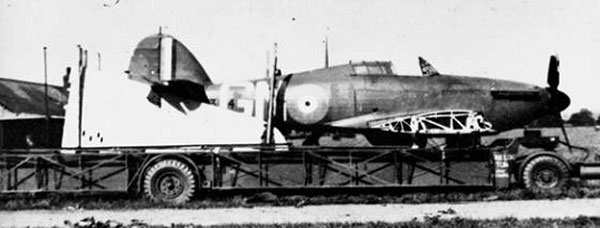Hurricane P3154 near Kirkbymoorside.
Details of this flight are vague at present but what is known that at 20.00hrs on 20th July 1940 this 249 Squadron aircraft's engine cut out when the engine was starved of fuel, which was later
put down to the pilot's misunderstanding how the petrol system cocks worked. He made a landing near Kirkbymoorside but the aircraft collided with obstruction cables (a wire hauser)
placed across Major Shaw's private airstrip at Welburn Hall near Kirkbymoorside. The aircraft was not seriously damaged and the pilot survived. Repair on site was considered but the
airstrip was too short to make a take off possible so the aircraft was dismantled and removed by road and later rebuilt. A photograph in Brian Rapier's "White Rose Base" book shows
the aircraft on the back of the lorry about to leave Kirkbymoorside (shown below).
Pilot - P/O John Reginald Cass Young RAF (70766).
John Young was born in July 1915 in Greenwich, London. He was granted entrance to Dartmouth Naval College in April 1929 but due to a serious illness had was forced to give this up
before it had started. He returned to college at Blackheath until September 1930 before trying to get into the Navy in 1931, he passed the course but only half of those who passed were
taken on by the Navy so he joined the Canadian Pacific and sailed (almost certainly) with the "Beaverbrae". In 1936 he went to work for Canadian Pacific on land in Canada and learnt
to fly in Canada. He was granted Canadian citizenship in November 1936 but returned to the UK six months later and trained to be a pilot as a civilian, he was granted a commission
in the RAFO as Probationary Acting P/O on 9th August 1937 and posted to 10 Squadron flying Whitleys at Dishforth as a second pilot/observer. He rose to P/O on probation on 31st May
1938, and then P/O on 21st June 1938. After training he was posted to instruct at Blackburn's Flying School at Brough before War was declared. In June 1939 he was called up and
passed an instructing course in July 1939 and was posted to 41 Squadron in August 1939 as an instructor and adjutant. He later served with 603 Squadron and then was posted to 249
Squadron on it's formation in May 1940 and served with them during the Battle of Britain (the squadron he was with at the time of his mishap at Welburn). He was promoted to F/O
on 3rd November 1939, F/Lt on 30th May 1941. Before the end of the War he served with numerous squadrons including 308, 317, 406, 289, 96, 29, 264 and 108 Squadrons. He was awarded
the AFC in January 1942 and was Mentioned in Despatches twice; once on 1st January 1943 and again on 15th July 1944. He rose to S/Ldr (war subs) on 15th October 1944 and survived
the War. He continued to serve in the RAFO after the war and later relinquished his Commission when he retired on 18th March 1953. He died in February 2007.
Hurricane R3154 was built to contract 96237/38 by Gloster Aircraft Ltd at Hucclecote and was delivered to the RAF in February 1940
and after acceptance was flown to 607 Squadron at Vitry-en-Artois, France in March 1940. It moved with the unit to Abbeville on 12th
April 1940, and returned to Vitry-en-Artois on 26th April 1940. It then moved to Norrent Fontes on 19th May 1940. 607 Squadron withdrew
from France arriving Croydon on 22nd May 1940 but without any aircraft. Hurricane P3154 made its way back to the UK and after
servicing was issued to 249 Squadron at Leconfield in June 1940 and the unit then transferred to Church Fenton on 8th July 1940.
It suffered Cat.R/FA damage in the incident at Kirkbymoorside; detailed above. After repair the aircraft was issued to 56 Squadron
at Boscombe Down in September 1940. The aircraft was to be written off later the same year whilst taking part in the Battle of Britain.
Sgt D.H.Nicholls of 56 Squadron was injured in combat over Yeovil at 16.00hrs on 7th October 1940. The aircraft crashed at
Alton Pancras, Somerset. Initially the damage was declared as Cat.R but after assessment was Re-Cat.W and struck off charge.

